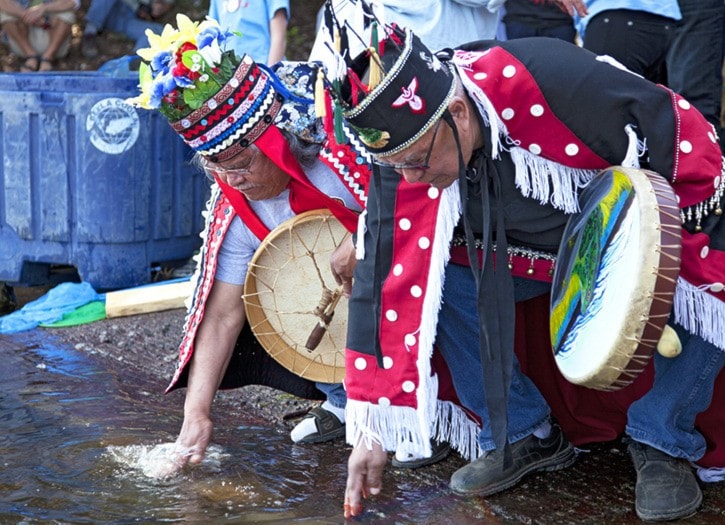Each spring, approximately 300 million juvenile salmon make their way from every lake, river and stream in the Skeena watershed to the saltwater refuge of the Skeena estuary.
On May 11, 2015, almost 300 people from across the Skeena watershed gathered at the Babine River to celebrate this natural wonder. The event has been dubbed “the invisible migration” because the millions of baby salmon are invisible beneath the Skeena’s brown floodwaters.
“The giant outmigration of baby salmon goes relatively unnoticed as it happens during the spring runoff, when rivers are high and muddy,” explained Shannon McPhail, Executive Director of the Skeena Watershed Conservation Coalition.
“If the rivers were clear, we would see giant clouds of the hundreds of millions of these baby salmon (also called smolts) making their journey to the Pacific Ocean,” she added.
The return of salmon has been celebrated for countless generations, but this was the first time that local First Nations celebrated the outmigration of baby salmon.
“It was very good to do this,” said Lake Babine Nation Chief Wilf Adam.
Chief Adam said organizers were surprised by the turnout.
“The event had a wonderful turnout as we were expecting around 60 people, and over 280 people showed up,” he said. “It was a great event as we released the smolts with the community, hereditary chiefs and singers.”
Activities during the event included jet boat tours of Babine Lake, helicopter tours, drumming and singing, bannock made fresh on the fire, button making and salmon barbecue.
Two other invisible migration events also took place downriver. On May 20, people gathered in Hazelton to celebrate the smolts as they passed through. And on May 23, in Prince Rupert, a final event took place to mark the salmon’s arrival at the Skeena estuary.
McPhail said the Skeena estuary is one of the most pristine and productive estuaries of its size in the world. It’s estimated that about 300 million salmon will arrive at the Skeena estuary by June 1.
“Every juvenile salmon that leaves the Skeena, feeds in the estuary; it is their nursery,” she said. “Juvenile salmon arrive at the estuary during one of the most sensitive times of their life, as they transition from fresh water to salt water.”
These young salmon will become the adult salmon that return to the Skeena watershed during summer and fall over the next 200 years.
McPhail explained that the abundance of Skeena salmon in the following years depends on the survival of juveniles migrating down the Skeena watershed right now.
“Salmon are the most valuable food source; they support our regions’ ancient and unique way of life.”
The Skeena estuary also happens to be the very place Malaysia’s state-owned Petrona is proposing a liquefied natural gas terminal - the Pacific NorthWest LNG project.
“There simply isn’t a worse location to site their terminal, they [Petrona] need to move,” said McPhail.
Greg Knox, Executive Director of SkeenaWild Conservation Trust, said he is concerned the terminal could damage the eelgrass beds that provide rearing habitat for all of the Skeena’s wild salmon. The abundant eel grass habitat of the estuary provides a refuge from predators, and food to grow, while juvenile salmon adjust to their new life in the ocean.
“The health of the estuary has been on the minds of many residents lately,” he said.
